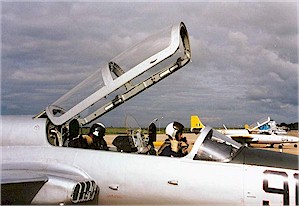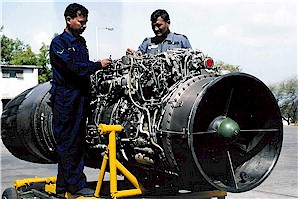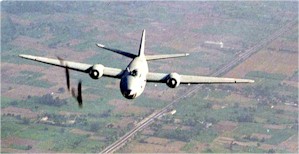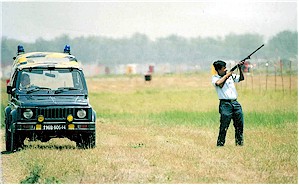This article was first appeared in the MilAviationSafety Group. Reproduced with permission
Finally we had a serving air marshal telling the country what MiG accidents and flight safety in the IAF is all about. IE 13 Aug 03 page 9, http://www.indianexpress.com/full_story.php?content_id=29479 Don’t shoot down IAF over MiG myths (Air Marshal Ashok Kumar Goel) “. Indeed there are more myths than truths floating around in India, and those relating to Defence Forces are phenomenal. The great arm chair strategists, self styled analysts, and so called defence thinkers must bear responsibility for this gross disinformation and whipping up of aphobia about MiGs. The media must also carry an equal burden for giving prominence toincorrect conclusions and letting emotions ride over sense of proportion. The earlier editorial “Flying Coffins?” IE 04 Aug 03 page 8 was probably the starting point in placing the truth about MiG accidents in correct perspective.
Most uninformed people are ignorant that by the time a young Flight Cadet in the Air Force Academy becomes an officer, he has been tested and checked out by many instructors and supervisors. A significant number of Flight Cadets who join Basic Training get suspended and are routed to Navigation or Ground Duty.Thus not all those who ‘join up’ become pilots. Very disappointing for the cadet and parents, but it has to be done. At the Basic flying school a cadet gets not more than 10 to 12 hours of dual flying with instructors before he can show ability to fly solo all by himself. If his ability to grasp the essence of take off, landing, simple maneouvring, is slower than what is laid down, out he goes. There is no place for him as a pilot in the IAF. On the other hand, at civil flying clubs, a trainee can take as long as he wants before the instructor will send him solo. The reason is simple. The flying club earns money for every hour of flying done, dual or solo. There is no rush to send the pupil pilot solo. In the IAF, Govt pays for the flying. It is free for the cadet. But there isan even more important and critical reason. A commercial pilot can take hours and years to build up his experience and reach an acceptable level of competence.
 |
“All cadets who become pilots in the IAF have to show consistency and competence.”
Two student pilots get ready to fly in an Iskra trainer at Hakimpet – Pic Courtesy : Phil Camp / Simon Watson |
In the IAF, the pilot has to demonstrate this ability swiftly and confidently. His final job will be to take an aircraft all byhimself, and deliver weapons with greatest of accuracy, and return to do it again andagain. There are no mandatory rest periods between strike missions. So it is abundantly evident that the demands that are placed on the MiG pilot will be high, they will be continuous, and these demands do not decay with time. It is with this aim in mind that cadets frequently get suspended from flying training and become Navigators or Ground Duty officers. There is no shame in suspension. Some of us are just not designed for military flying. Call it genes, attitude, DNA, or whatever, some have it, others do not.
The tragedy is that in many cases of suspensions the parents bring about pressure on the IAF to get extension of training for their sons. While the disappointment is understandable and flying instructors hate tosuspend a cadet, when it has to be done, it must be done. The public must appreciate that a suspension is not a punishment, but an honest statement that the boy does not have it in him and he must pursue a different profession. The suspension also has that crucial element of Flight Safety which says that, continuance in pilot training is dangerous forthe boy, and for others with him and around him. To force the IAF to extend his training by a few hours will not achieve the desired competence, on the other hand it will increase the risk to the boy. It is pertinent to reiterate that the ability to swiftly grasp the technique, and become reasonably proficient in flying newer and newer aircraft, is a requirement that is demanded throughout the career of a military pilot. It is not enough to be able to do this just at the basic stage. That is why a flying instructor makes avery considered judgement when he recommends or rejects the continuation of flying training during the Basic, Intermediate, Applied and finally at Operational levels. Andthe approval or rejection, is cross checked by many supervisors. It there fore follows that, all cadets who become pilots in the IAF have shown some level of consistency and competence. This does not mean that he is a superior pilot. Like pilots all over the world, military or civil, the majority of pilots in the IAF are average to average plus.
The world is made up of at least 75% average people, and it is these 75% who make it all happen. The exceptional constitute about 10% to 12% with an equal number below average, making the total 100%. If there were too many exceptional performers, the earth would stop spinning, So despite the rigorous filtration at many stages of training, the final output is by and large average to average plus pilots that enter IAF squadron service. It is at this Operational stage that he becomes more skilled and develops greater competence. Some become experts, most remain the workhorses of the IAF, with good skills to manage all standard exigencies and emergencies of life, both in the air and on the ground. When unforeseen situations arise, and the demands exceed the normal competency levels, most pilots innovate and recover to return safely and tell their tales. Some are unable to cope with the situation and do not return.The IAF, like all other Air Forces accept this situation. It is a reality that one cannotrun away from. It is easy to ask the IAF as to why it permitted an average pilot to fly.The questioner must ask himself, and answer it honestly, then the truth emerges. The answer lies in the fact that all aircraft are designed to be flown by average pilots. Thedesign, the stability, the limits, and emergencies are made for average pilots. If aircraft were designed only for superior pilots, there would be a tremendous scarcity of pilots the world over. When the average pilot fails to handle an unforeseen situation, or mishandles a foreseen and rehearsed situation, accidents occur. Many times these accidents are minor with little damage to pilot and machine. Other times they result in loss of aircraft but retrieval of pilot, and sometimes both are lost. Tragic but an inevitable and unfailing facet of military aviation. The public, and opinion makers with aggressive access to media, must acknowledge these aspects before arriving at judgmental conclusions.
Yet another aspect of military aviation is that there is no commercial compulsion to fly the aircraft. If the MiG does not fly for 5 days, nothing untoward will happen. But if a Boeing 737 of Jet Airways remains on ground for more than its scheduled time, untold pressures build up, mainly commercial. So to believe that MiGs that are unfit to take off are launched into the sky is totally misplaced. If the MiG, or Mirage, or Jaguar or AN-32 is not fully serviceable, it need not fly and it will not fly. Let it be clearly understood by the so called ‘ concerned’ NGOs,analysts, opinion makers, legislators, bureaucrats and private citizens, if an IAF pilot finds his aircraft unserviceable, he will not fly it, and he cannot be made to fly it.When war breaks out it is different. To therefore believe that the MiGs that have crashed were unserviceable flying machines, is false. A machine can and will fail at any time. It is applicable to a car, scooter, generator, pump, the heart, or an aircraft. Nothing canforetell when failure will happen. Periodic servicing, and close monitoring of parameters can at best give indication of impending malfunction. Complete failure, impossible toforecast. Aircraft engines run flawlessly for 10,000 hrs, and yet the same type of enginemay fail after just 500 hrs. The thousands of parts that make an aircraft have their own peculiarities and life cycles.
| “no technician in the IAF will certify an aircraft airworthy, if it is not so”
Two airmen work on a fighter engine. |
 |
Recollect the Concorde tragedy in ParisFrance. The Concorde continued to fly for two years more before retiring recently. The Concorde’s technical life was over. That is not the case with MiGs. They have lots of lifeleft. Those that are unfit to fly have gone into what is sadly called the aircraft graveyard, to be chopped and made into pressure cookers. Those that are airworthy will bechecked for serviceability and they will fly, and average pilots will fly them. When it issaid that the MiG-21 is an unforgiving aircraft, it does not mean that minor errors resultin fatal accidents. It means that if a pilot mishandles a MiG 21 beyond its normal limits,the aircraft may not recover and especially so at low altitudes. Gross mishandling atheights like 6 to 7 kms gives the average pilot enough time and space to seek the forgiveness of the MiG 21. And this quality is not unique to the MiG 21 only. There aremany fighter and transport aircraft that will not forgive a pilot his misdemeanorespecially at low heights. Why blame the MiG 21 and call it an ‘unforgiving’ aircraft. Ifit were so, we should have lost 70% of all pilots who flew MiGs in the 60s and 70s andindeed many of them made terrible errors. After all, they were just as average as the average pilots of today! It is quite clear that the pilots who are flying MiG 21s are notwizards nor are they incompetents. It is also clear that the MiG 21s flying with IAFcolours are not unserviceable or non airworthy aircraft. It is also apparent that no IAF pilot can be made to fly an aircraft that is unserviceable. Before the question arises, itcan be stated that no technician in the IAF will certify an aircraft fit, if it is not so. For both the pilot and technician, there are no financial and commercial imperatives tomake an unserviceable aircraft fly. Which brings us to the next point that is why then areso many accidents taking place? Is that a correct statement to begin with? Are therereally ‘so many’ accidents?
| “If a pilot mishandles a MiG 21 beyond its normal limits, the aircraft may not recover and especially so at low altitudes”
A MiG-21U Trainer of the Hawkeye Squadron |
The statistics given out by the Inspector General of the IAF, clearly indicate a downward trend in accidents. Certainly, and mostsurely, there is a crying need to reduce the accident rate further and further. But to expect zero accidents is utopian. The Almighty, whatever His name, did not design man tofly, but gave him the ingenuity to do so with engineering prowess. The concentration ofeveryone is on the MiG, IAF, Min of Defence, spares, competence of pilots and emotiveissues. But there are equally germane issues that never get mentioned. First is thebusiness of the MiG being a terribly dangerous machine to fly, and all those young pilots who are being ‘ forced’ to fly it, and thus are about to get killed. The nation must be aware that at Tezpur in Assam, where young pilots are given Operational training, the MiG21 flies close to 10,000 hours in one year. Every day, right across the Indian skies, MiG21s fly day and night. How come not one NGO, not one paper, not one TV channel, not oneset of parents, not one defence analyst, not one cartoonist ever makes much of this fact?When a MiG crashes, every body screams murder. When MiGs fly and do not crash, no onebothers. Parents and others will say, MiGs are not supposed to crash. True indeed, theyare not supposed to crash, but they do and will. Recollect that most pilots who fly MiGs,are average pilots, who are trained to manage emergencies and numerous unforeseen situations. Most come back having tackled emergencies, some make mistakes and get hurt or damaged, some are lost for ever. It is a measure of the quality of training in the IAF,that most emergencies are successfully overcome by these average pilots. If truly the MiG was such a terrible and unforgiving aircraft, we should have written off the fleet by now,and with it more than 500 pilots. And what is more, if indeed the MiGs are as unsafe asmany would have us believe, our average pilots would be ejecting out of the aircraft withthe tiniest of problems. It is not happening, does anyone wonder why not? There is too much of romanticising fighter pilots based on Top Gun and other Hollywood mush. But in Top Gun also pilots die and average pilots make mistakes from which they recover.
An important and neglected arena is theenvironment. From the days that the first MiG flew with Indian colours in 1964, till today, the environment around our air bases has become increasingly hostile. Housing colonies and industry have mushroomed around Air Force stations. This has increased bird activity in the form of vultures and kites that circle around looking for garbage to feedon. Slaughter houses have come up at locations that are smack in the middle of the take off path or landing approach. Proliferating industry brings with it migrant labour wholive in jhuggis and generate garbage that is never removed by local municipalities.
A bird ingestion into the engine invariably results in Shut Down, and if this happens on Take Off or Landing Approach, where is the height to attempt a Restarting of the engine. In most cases the pilots have to eject, and if the height above ground is not enough, the parachute will not deploy fully and the pilot suffers severe injuries or is killed. All attempts to limit habitation around airforce bases fail miserably and the judiciary just does not understand the dangerous implications of butcheries and open garbage dumps on take off paths. Appeals to relocate fall on deaf ears and judicial processes take years. So the MiGs, and all other aircraft,including civil airliners, have to fly through flocks of birds at all times of the daywith attendant dangers to both aircraft and pilots.
Has any NGO, association, group of affected parents, politicians, bureaucrats and the media ever highlighted this issue and trumpeted the fact over and over again just as they do about MiGs being flying coffins? There are laws passed by parliament about sanitation around all airports, unfortunately the law isto be enforced by the State Govt and local police, supervised by lower courts. It does not work and the tragedy is that not a single High Court nor the Supreme Court has thought it fit to intervene, and bring about some method in this madness of providing a safe environment for Air Force aircraft.
Environment also means the attitude of the intelligentsia, policy makers, analysts, and of course the media, both print and electronic. They too are hostile towards the Defence Forces. A little noise here and thereabout Kargil, and Hillkaka is not what is needed to make flying safe. A structured and well illustrated campaign on Flight Safety and Flying Training in the Indian Air Force needs to be broadcast on TV. The same channels that report so disparagingly about MiGs,and lack of concern for life of pilots, and the ‘unforgiving’ aircraft, and so on, should take up this cause and refurbish the faith of their viewers in the Air Force, its aircraft and pilots. A great disservice has been done, and it has to be remedied by the very peopleand organizations that did the disservice. Every city that has an airport or Air Force Station also has a local Cable TV supplier. The environment for safer flying can be easilyboosted through Cable TV education for as little as a one minute programme every evening.
The Inspector General’s Branch at Air HQs will be eager to help any NGO, Quasi Govt, Lions / Rotarians, and such groups. The initiative must come from those who are concerned and care, and feel a part of the causefor safer flying environment. Like the campaign for a less noisier Diwali, a cleaner Ganga, rehabilitation of challenged persons, educating the Girl Child, AIDS, this crucialissue needs to be projected aggressively. Making flying safe in the Indian skies is not the exclusive responsibility of the Indian Air Force. After all, the IAF flies in theIndian skies because India exists, then surely, Indians from all walks of life must assist in making flying safe.
There is no gainsaying that the accident rate of the IAF can be lowered further, and certainly it is being done. It is inconceivable to believe that the air marshals of the IAF are unconcerned and neglecting their responsibilities towards junior pilots who make up the ‘sharp end of the spear’. Therecent approval of the AJT, 20 years too late, is a glaring example of the hostile environment within which the Air Force operates, and keeps itself ready for war. Thepolitician – bureaucrat combine is a powerful and insurmountable entity, and nothing, noteven disasters and calamities can budge them out of their inherent disinclination to do what must be done for the Defence forces. Yet it is expected that the IAF will deliver its weapons of war accurately. The IAF does it, as has been abundantly demonstrated in 1962, 1965, 1971 and 1999 at Kargil. The uninterrupted supply and relief missions by Transporters and Helicopters, is a reiteration of the integrity and loyalty with which the IAF serves the nation. The charter for the IAF is dictated by the demands of the nation state, and its Threat Perception. It is not a document written with emotional overtones,and psychological dictates. MiG 21s that are flying even as this is being read, are fully serviceable and piloted by trained officers. It will be a gross injustice if the public,the media, the NGOs, the affected parents and relatives, analysts, and policy makers,condemn a perfectly safe aircraft, and its pilots for inaccurate reasons. Much damage has been done by publication of misleading information, but the situation is retrievable andmust be activated in the greater interest of our nation and its Air Force. A final inputfor the readers. The unique situation in the Air Force, unlike the Army or Navy, is that only the pilots, who are officers, go into battle. It is unthinkable, implausible,unimaginable and certainly outrageous and absurd to believe that, senior pilots will create conditions, and place obstacles so as to debilitate their successors.
Indeed there are a few, both seniors and juniors, who are guilty of letting their egos overtake better judgment. Our endeavor is to live with it and win. It has been done earlier, and must be done unceasingly.
This article was first appeared in the MilAviationSafety Group. Reproduced with permission

